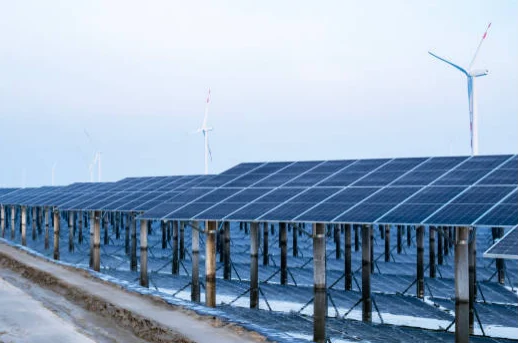2025-01-17
Saltlight Complementary Power Station is a brand-new model that combines the photovoltaic technique with traditional salt production to explore another brand-new path for the development of new energy. We can imagine rows of photovoltaic panels on a vast salt field, dressing up a layer of bright new clothes on the earth, not only without affecting the operation of the ancient industry of salt printing but also efficiently generating clean energy on the water and even culturing underwater in some cases to form a three-dimensional ecological cycle system.

High space utilization: Setting a photovoltaic panel at a distance from the bottom of the salt pond, realizing the trinity function of hydropower generation, desalination or salt printing by water, underwater aquaculture, and greatly improves the output value of the land unit area.
Resource efficiency: it ensures the solar energy resource utilization to its fullest to have every piece of sunlight used in the production of electrical energy; to modernize salt production, it promotes the modernization of salt and refined management.
Huge ecological benefits: less dependence on fossil fuel, less emission of greenhouse gases, promotion of green and low carbon development, improvement of ecological and environmental quality at regional levels.
Huadian Tianjin Haijing "Salt-Light Complementary" Project: One of the landmark projects of China Huadian Group, it is located in Changlu Salt Farm, Tianjin Binhai New Area, with a total area of 20,000 mu. It has the potential to provide 1.5 billion KWH of clean electricity every year and reduce approximately 1.25 million tons of carbon dioxide equivalent, enough to cover the electricity demand for 1.5 million households annually. Herein, the important thing is using a double-faced generating that allows the PV panel to gather not only upper direct light but also reflected beams from the ground onto it. This water surface reflection mechanism ensures an increase of 5 percent up to 7 percent in general power generation output. Besides this, what has been introduced at present is a "low-carbon booster station," which reduces green electricity transmission losses further.
Hainan Yinggehai Salt Farm Nachao Lake 200MW photovoltaic project: With the largest beach photovoltaic project in Hainan Province, it has reached an installed capacity of 200 MW in total. When it is in operation, it can produce 320 million KWH electricity annually and save about 128,000 tons of standard coal while reducing 318,000 tons of carbon dioxide emission. The project overcame many construction difficulties, such as water transportation of materials and pile driving, and completed the perfect integration of water power generation and water salt extraction.
A complementary power plant based on the model of Salt-Light represents a traditional energetic structure attempt at a creation to promote further reaching sustainability goals in their attainment and embodies concretization toward creating a brighter, environmentally promising future in respect to both economic development and nature preservation.
As an innovative new energy project, the complementary power station of Yanguang indeed provides a bright road for sustainable development. It also faces some unique challenges in planning, construction, and operation. Here are the main ones
Environmental adaptability
High corrosion: The salt pan environment is of very high salt concentration, which is a serious corrosion risk to the photovoltaic modules and other electrical equipment. If this environment is experienced long enough, it can lead to accelerated material aging, affecting stability and the lifetime of the system.
Difficulty of construction on water
The installation of photovoltaic panels on the surface of the water requires particular engineering conditions, like how to ensure structural stability, how to solve buoyancy problems, and how to deal with natural elements such as wind and waves.
Optimization of Two-sided Power Generation Design
While double-sided power generation is more effective, the best results entail taking into consideration correct calculations concerning factors such as reflectivity and Angle, which also increase the initial investment costs.
Ecological Balance Maintenance
Impacts on aquatic ecosystems: Though the salt-light complementary model is not intended to hinder the process of salt-printing for power generation and farming, it is relevant to consider whether it will have adverse impacts on the local aquatic biodiversity.
Water quality management
Guarantee water quality standard not to be polluted or changed by the operation of the power station so as not to affect the quality of salt production and the success of aquaculture.
Economic feasibility
Large initial investment: the pre-construction cost of Yanguang complementary power station is higher than the traditional ground station, such as special anti-corrosion treatment and support system customization, etc.
Income uncertainty
Although this model can bring multiple benefits in the long term, in the short term, the benefit can be influenced by weather conditions such as light intensity, fluctuation in market electricity price, and other factors.
Insufficient policies
As an emerging thing, in some regions, perhaps due to a lack of specific guidelines related to saltlight complementary power plants, the project approval speed, and development scale may also be affected. It is also required that the entire project should not conflict with any related national and local laws and policies relevant to environmental protection and energy development.
In other words, although the complementing power station built by salt and light has a lot of advantages, meeting the above challenges is also needed in order for it to truly become effective in promoting green transformation.